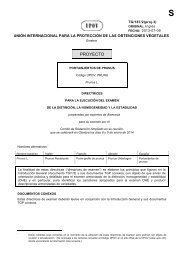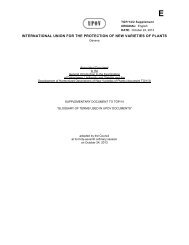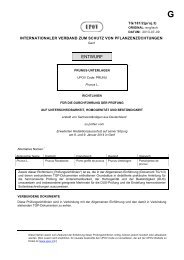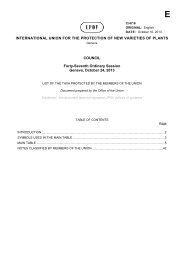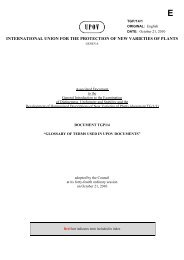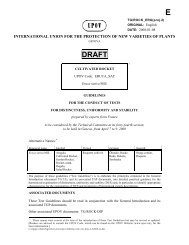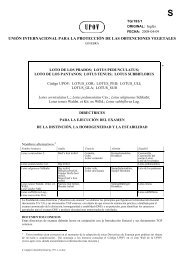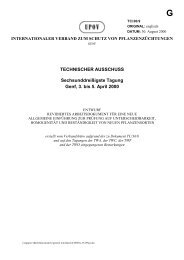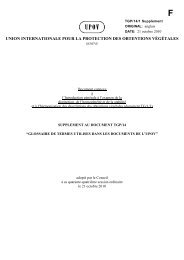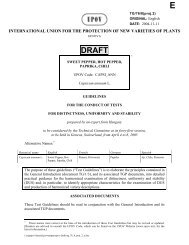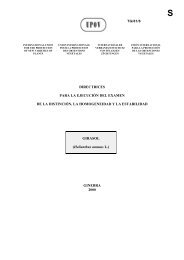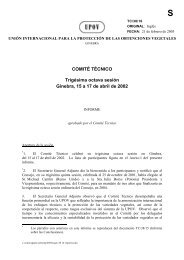Explanatory Notes on Essentially Derived Varieties under the
Explanatory Notes on Essentially Derived Varieties under the
Explanatory Notes on Essentially Derived Varieties under the
Create successful ePaper yourself
Turn your PDF publications into a flip-book with our unique Google optimized e-Paper software.
“VI. The questi<strong>on</strong> of <strong>the</strong> Degree of Similarity<br />
“[…]<br />
CAJ-AG/12/7/3<br />
page 6<br />
“21. To fulfill <strong>the</strong> c<strong>on</strong>diti<strong>on</strong>s imposed by Article 14(5)(b)(iii) a later variety must c<strong>on</strong>form to <strong>the</strong> initial<br />
variety in <strong>the</strong> expressi<strong>on</strong> of <strong>the</strong> essential heritable characteristics of <strong>the</strong> initial variety ‘except for <strong>the</strong><br />
differences which result from <strong>the</strong> act of derivati<strong>on</strong>’. Theoretically, if variety A is crossed with variety B and<br />
Variety X is selected from <strong>the</strong> resulting progeny, if variety X derives less than half of its essential heritable<br />
characteristics (i.e. from its genotype) from A and more than half from B, it will be essentially derived from<br />
B since apart from <strong>the</strong> characteristics derived from A, it c<strong>on</strong>forms to <strong>the</strong> expressi<strong>on</strong> of <strong>the</strong> essential<br />
characteristics of B. This is clearly not <strong>the</strong> intended interpretati<strong>on</strong>. A later variety cannot fulfill <strong>the</strong><br />
c<strong>on</strong>diti<strong>on</strong>s of Article 14(5)(b)(i) unless it is predominantly derived from <strong>the</strong> initial variety while retaining,<br />
without qualificati<strong>on</strong> in Article 14(5)(b)(i), <strong>the</strong> expressi<strong>on</strong> of <strong>the</strong> essential heritable characteristics of <strong>the</strong><br />
initial variety.”<br />
19. The records of <strong>the</strong> discussi<strong>on</strong>s at <strong>the</strong> IOM/6 <strong>on</strong> <strong>the</strong> above proposals are c<strong>on</strong>tained in document<br />
IOM/6/5 “Report” and are reproduced in Annex II to this document.<br />
20. Copies of documents IOM/6/2 “<strong>Essentially</strong> <strong>Derived</strong> <strong>Varieties</strong>” and IOM/6/5 “Report” in <strong>the</strong> four<br />
languages of <strong>the</strong> Office of <strong>the</strong> Uni<strong>on</strong> will be posted, as reference documents, at <strong>the</strong> CAJ-AG/11/6 secti<strong>on</strong> of<br />
<strong>the</strong> UPOV website.<br />
21. The CAJ, at its thirty-sec<strong>on</strong>d sessi<strong>on</strong> <strong>on</strong> April 22 and 23, 1993, and <strong>the</strong> Technical Committee, at its<br />
twenty-ninth sessi<strong>on</strong> held <strong>on</strong> April 21 and 22, 1993, decided as follows: (document CAJ/32/10-TC/29/9<br />
“Report”, see Annex to document CAJ-AG/09/4/3, page 100):<br />
“Guidelines Relating to <strong>Essentially</strong> <strong>Derived</strong> <strong>Varieties</strong><br />
“28. The Chairman asked whe<strong>the</strong>r a list of sample cases in which a variety would be essentially derived<br />
should be drawn up at <strong>the</strong> present stage, or whe<strong>the</strong>r <strong>on</strong>e should ra<strong>the</strong>r await <strong>the</strong> entry into force of <strong>the</strong><br />
provisi<strong>on</strong>s c<strong>on</strong>cerned and <strong>the</strong> accumulati<strong>on</strong> of some initial practical experience. In <strong>the</strong> first hypo<strong>the</strong>sis <strong>the</strong><br />
questi<strong>on</strong> that arose was how to incorporate <strong>the</strong> advice of breeders in <strong>the</strong> Guidelines, as <strong>the</strong> Guidelines<br />
were addressed to <strong>the</strong>m; in that case <strong>the</strong> form of <strong>the</strong> document would also have to be specified.<br />
“29. The Delegati<strong>on</strong>s of Germany, France and <strong>the</strong> Ne<strong>the</strong>rlands were of <strong>the</strong> opini<strong>on</strong> that <strong>on</strong>e could not<br />
draw up a list in <strong>the</strong> abstract, which moreover would be liable to be taken as an exhaustive list, and that<br />
<strong>on</strong>e should wait. It was also menti<strong>on</strong>ed that <strong>the</strong> work of <strong>the</strong> Working Group <strong>on</strong> Biochemical and Molecular<br />
Techniques would greatly c<strong>on</strong>tribute to <strong>the</strong> definiti<strong>on</strong> of <strong>the</strong> essentially derived variety c<strong>on</strong>cept in practical<br />
cases.<br />
“The Chairman c<strong>on</strong>cluded that this agenda item could be adjourned sine die.”<br />
(iv) Discussi<strong>on</strong>s that took place during <strong>the</strong> fifth sessi<strong>on</strong> of <strong>the</strong> CAJ-AG<br />
22. At <strong>the</strong> fifth sessi<strong>on</strong> of <strong>the</strong> CAJ-AG, held in Geneva <strong>on</strong> October 18, 2010 and <strong>on</strong> <strong>the</strong> afterno<strong>on</strong> of<br />
October 19, 2010, <strong>the</strong> representative of CIOPORA explained that for CIOPORA, to avoid legal uncertainty, it<br />
was necessary to clearly define <strong>the</strong> difference required for a variety to be c<strong>on</strong>sidered not to be an essentially<br />
derived variety. He explained that <strong>the</strong> extensi<strong>on</strong> of <strong>the</strong> protecti<strong>on</strong> of an initial variety to its essentially derived<br />
varieties provided an effective means of protecti<strong>on</strong> for those essentially derived varieties that would have a<br />
short commercial life. CIOPORA c<strong>on</strong>sidered that varieties obtained by mutati<strong>on</strong> should be c<strong>on</strong>sidered to be<br />
essentially derived varieties, irrespective of <strong>the</strong> number of differences. Therefore, he did not agree with <strong>the</strong><br />
final sentence of paragraph 12 of document CAJ/29/2 “Guidelines to essentially derived varieties” and of<br />
paragraph 12 of document IOM/6/2 “<strong>Essentially</strong> <strong>Derived</strong> <strong>Varieties</strong>”, which stated that “[…] <strong>the</strong> differences<br />
which result from <strong>the</strong> act of derivati<strong>on</strong> should be <strong>on</strong>e or very few.” (see document CAJ-AG/10/5/7 “Report”,<br />
paragraph 14).<br />
23. The CAJ-AG expressed c<strong>on</strong>cerns with regard to CIOPORA’s positi<strong>on</strong> that all mutati<strong>on</strong>s were<br />
essentially derived varieties (see document CAJ-AG/10/5/7 “Report”, paragraph 15).<br />
(b) Matters c<strong>on</strong>cerning essentially derived varieties arising after <strong>the</strong> grant of a breeder’s right<br />
24. At <strong>the</strong> sixty-first sessi<strong>on</strong> of <strong>the</strong> CAJ, held in Geneva <strong>on</strong> March 25, 2010, <strong>the</strong> Delegati<strong>on</strong> of Japan<br />
expressed an interest to learn more about <strong>the</strong> experience of o<strong>the</strong>r members of <strong>the</strong> Uni<strong>on</strong> <strong>on</strong> matters that<br />
might be raised after <strong>the</strong> grant of <strong>the</strong> breeder’s right c<strong>on</strong>cerning essentially derived varieties and provided <strong>the</strong>



